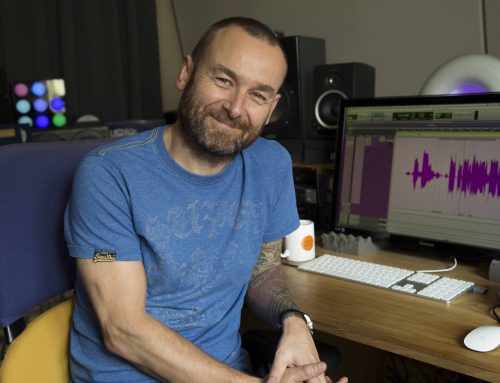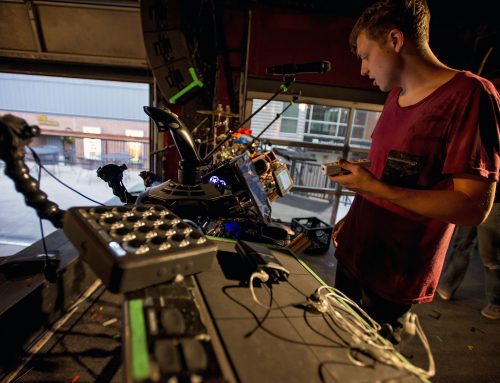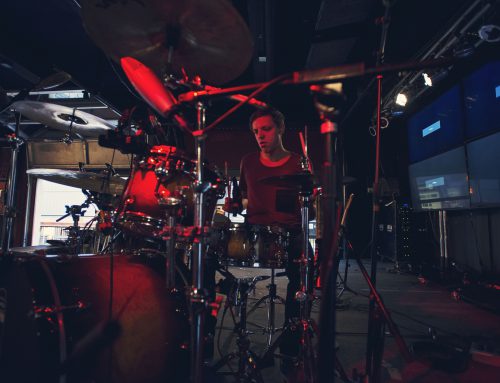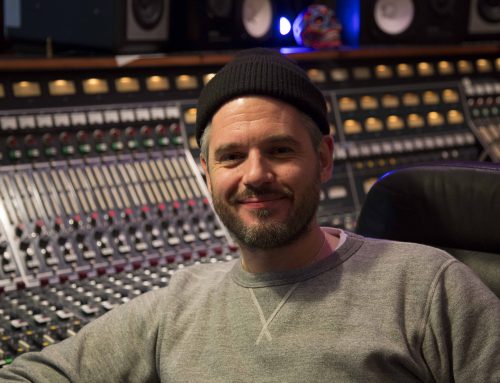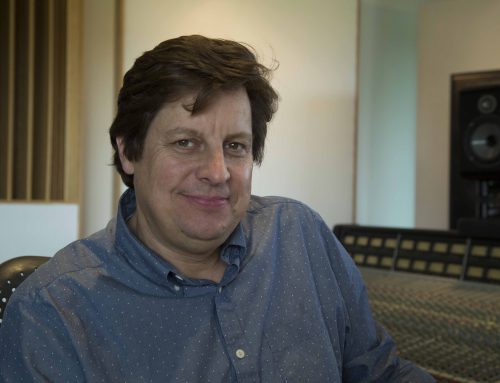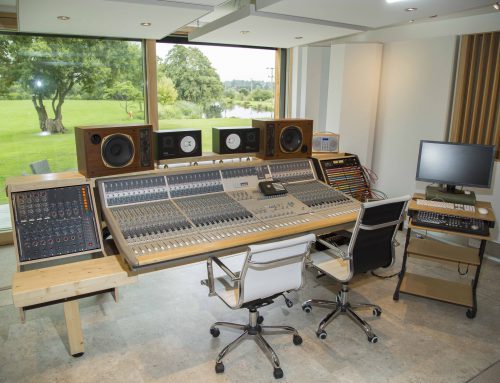Hugh Padgham is one of Britain’s best known and most successful producers, renowned for his work with The Police, Phil Collins, Sting, Genesis and countless others, but it is only recently that he set up his own studio, called Sofa Sound, in a North West London.
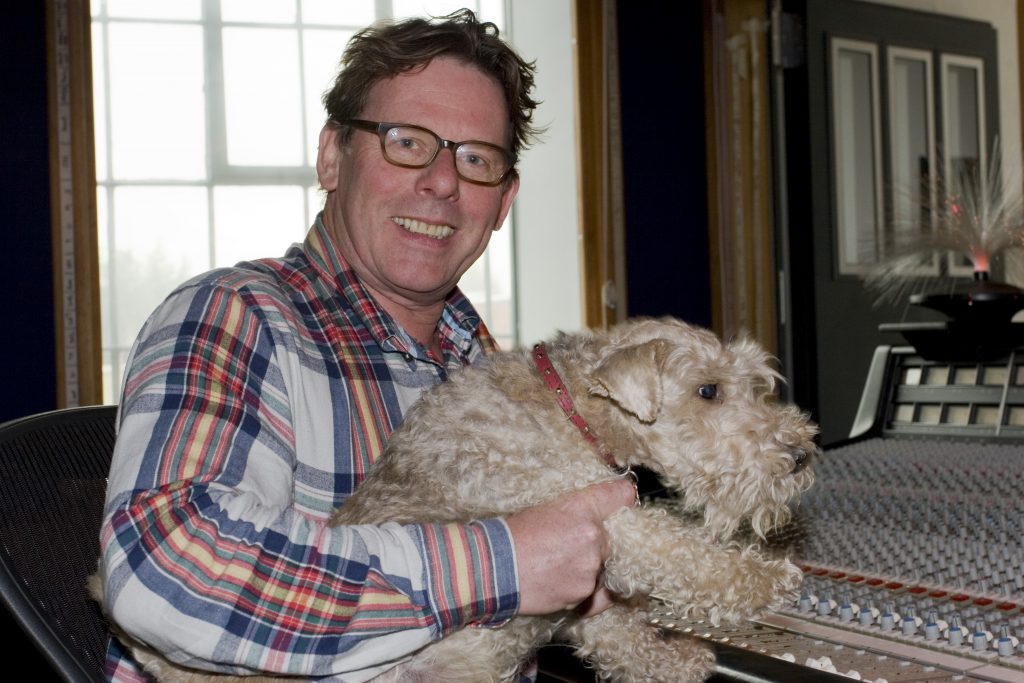
Hugh and Stanley at Sofa Sound. Photo by TF
Hugh Padgham seems very much at home at Sofa Sound Studio, arriving to do the interview together with his wife’s dog, Stanley, who is a star in his own right, having been immortalized in the Cath Kidston range of products. Hugh suggests we start the interview sat in the large control room between his beloved SSL G+ 64-channel console and racks of analogue processors. Beyond the SSL’s meter bridge is a window looking on into the live room, which is also home to the Yamaha upright and Wurlitzer electric pianos, a cabinet full of Hugh’s favourite microphones and a couple of acoustic screens on wheels.
“I would have liked a slightly bigger live room,” he admits, “but I was very lucky to have inherited the studio already made. I fell on my feet in that respect.”
To the right, a door leads into is a small control room containing the Pro Tools HD3 Accel rig and Studer A800 MkIII 24-track recorder. On the other side of the studio is the acoustically untreated entrance hall, which is still put to occasional good use.
“It’s very ambient,” says Hugh. “If you put microphones in the corridor and squash them with compressors, you can get a very good drum sound.” The corridor also has several very large windows which let natural light into the building, and through to the live room itself. “It’s lovely having these big windows, because daylight is uncommon in studios,” he continues. “Everyone who works here loves that side of it and if you are going to spend all day somewhere it may as well be somewhere nice.”
At the back, to the right of the stairs and elevator, are the two booths, the first of which is used for vocal recording, the second acting mainly as a storage area and home to the huge EMT 140 plate reverb, roughly the size of a double bed mattress standing on its edge.
One Lucky Owner
When Hugh first arrived at Stanley House, an Edwardian warehouse converted into a state-of-the-art studio complex by the previous owner, it was merely to look at the SSL console that was for sale. A few months later, not only did Hugh own the desk, he also owned Stanley House itself, including its bar and roof terrace! He is now clearly very proud to possess the property, having named the studio Sofa Sound and had it filled with all his favourite equipment, but he saw very little need to own or even run a studio until industry changes forced him to reevaluate his working methods. “In the old days there were hundreds of studios,” he explains, “so there was no point going to the expense of buying gear when someone else would pay for you to go into a studio that’s better than something you could afford to set up yourself, and I was used to working in the top studios. But by the mid ’90s the budgets weren’t paying for us to do vocal overdubs in studios costing £1200 a day, so my assistant and I set up a small room in the basement at The Townhouse Studios.
“We did our main recording work in the large studio, but could overdub using the booth in our room. For mixing we simply used the big studio again. Unfortunately the studio became harder to book because all the others in London were closing down, so I thought ‘Now’s the time to make the jump’. You can’t always dictate exactly when you are going to want to mix so it was all about finding a studio I could use when I needed to. Having that freedom is massive, really.”
Hugh’s plan was to rent out a suitable space and turn it into a studio, but first on his list of priorities was to find an analogue console, ideally an SSL, which were beginning to become relatively affordable.
“The weird thing is that even though there were loads on the market I was struggling to find the console that I wanted,” laughs Hugh. “I didn’t want it to be too old and ropey. I was looking for a new desk, but without moving fader automation. I’ve never liked seeing faders going up and down; it’s completely irrelevant to music as far as I’m concerned. Also, if you are going to have your own studio without a full-time maintenance engineer, you don’t want things that go wrong and they are more likely to go wrong. Secondly, I wanted VU meters rather than bar-graph ones. Bar-graph meters don’t really tell you anything. If you have them set to peak level they just tell you what peak is, whereas I can turn all the monitors down and pretty much tell you what instrument is playing just by looking at the movement of the needles. If you understand how VUs work they are much more informative. Again, bar-graph meters are more likely to go wrong.”
Eventually, Hugh found the SSL he wanted, which was installed at Stanley House. The console was in “incredibly good” condition, the only problem being that, being a G+ SSL, it was fitted with the standard G+ EQ rather than the much loved E type. “It’s a G+ console but I’ve always preferred the E EQ which has bass and treble ends that you can switch from bell to a shelf curves. The G+ EQ couldn’t do that and there are various other subtle differences, so I persuaded the company who sold it to me to swap the EQs. I ended up with the perfect console.”
During the conversation, Hugh asked the studio owner what he intended to do with the place once he’d sold the desk. It turned out that he was moving out altogether as was his business partner, who had blocked up the control room window to make the live area into a writing room. The control room was used purely for mixing at that point. Interested in renting the studio, Hugh spoke to the studio manager, and before he knew it, the place was his. “It was brilliant because I was expecting to take the console to another premises and then spend six months putting a studio together, but I inherited a proper studio!
“I was a tenant for four or five months before the owner declared he wanted to sell the building. My first thought was ‘I’m going to have to move everything out’, but I didn’t want to so I ended up buying it all. The people who converted the building into a studio also built loads of programming suites, which I now let out too.”
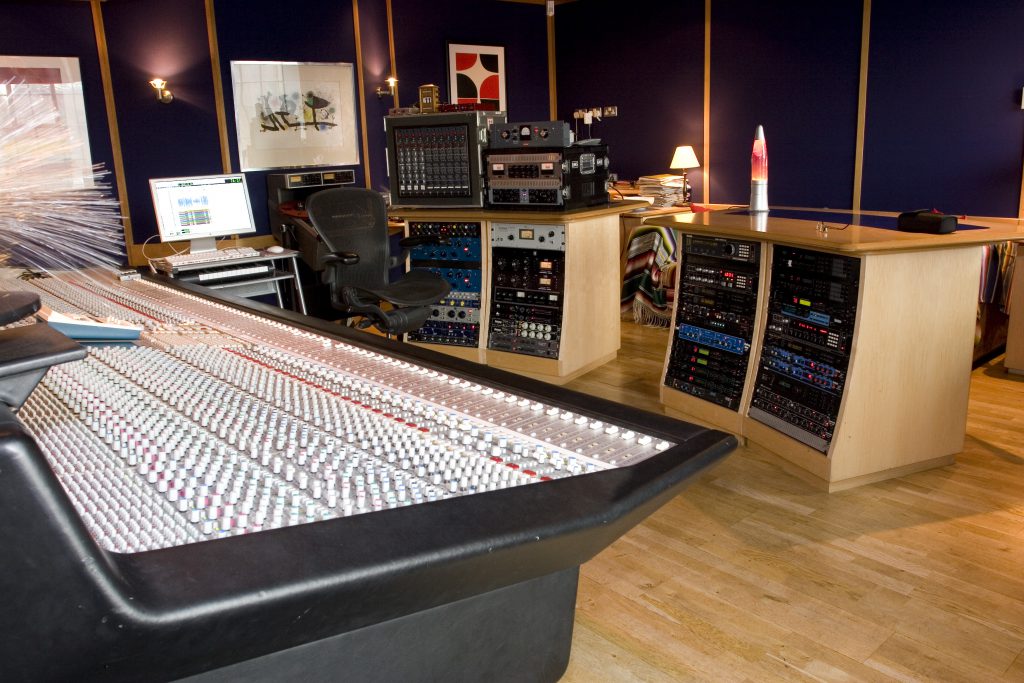
Looking across the control room from the door
The Setup
In setting up Sofa Sound, Hugh wanted to create a facility that combined all the good things he’d experienced in the other studios. Aside from the SSL console, this included having a collection of the best microphone, speakers, and outboard equipment. “At first I just had a few bits and pieces that were my favorite bits of gear, but once I’d bought the desk I thought I may as well have a 24-track, and then an analogue 2-track! So I have a Studer A800 MkIII 24-track, kept in impeccable condition, and a completely reconditioned Ampex ATR100 analogue half-inch two track, which is usually thought of as the best sounding analogue two-track ever made. That’s partly down to the heads, but mostly the electronics. You can get different heads but I think these are the Japanese Saki heads.”
Initially the studio was intended just for Hugh’s own projects, but he was soon approached by the management company Miloco, who were looking to add top-class West London studios to their roster in response to the closure of Eden, Townhouse and Olympic studios. “The deal I’ve set up with Miloco is great because, if I’m not working in the studio, they put people in here rather than have it left empty. They’re good at promoting and looking after private studios, although up until August this year I’ve been in here all the time working on three projects.
“I don’t work elsewhere very much anymore. I no longer want to be in a hotel for three months – I’ve got a family. When I was in my mid 20s to mid 30s it was very exciting to go to LA and New York and work in these famous studios, but it doesn’t appeal now that I don’t have the necessity to go. If I want to record a band in America I can track there and then get them to overdub and mix here.”
Now that Sofa Sound is used by other producers, Hugh maintains a very highly specified Pro Tools HD3 system, using Digidesign soundcards and software, Apogee AD/DA16x converters and Big Ben clock. “Personally, I don’t use Pro Tools very much,” admits Hugh, “but I keep the latest set of plug-ins because when I rent out the studio, a lot of young engineers and producers don’t know any of this outboard stuff, so you have to keep everybody happy! Now it’s a lot of old stuff, a lot of new stuff and everything in between.”
As far as studio ergonomics are concerned, most of the big decisions had been made when the facilities were built, years before Hugh bought the place, so the changes he has made have been minor ones. “I’ve done subtle work on the acoustics in the control room but it was very well built. I put in more analogue microphone cables between the front and back of the room so that when people bring their own keyboards or more outboard gear, they can set it up on a desk, plug it in and it comes up on the patch bay.”
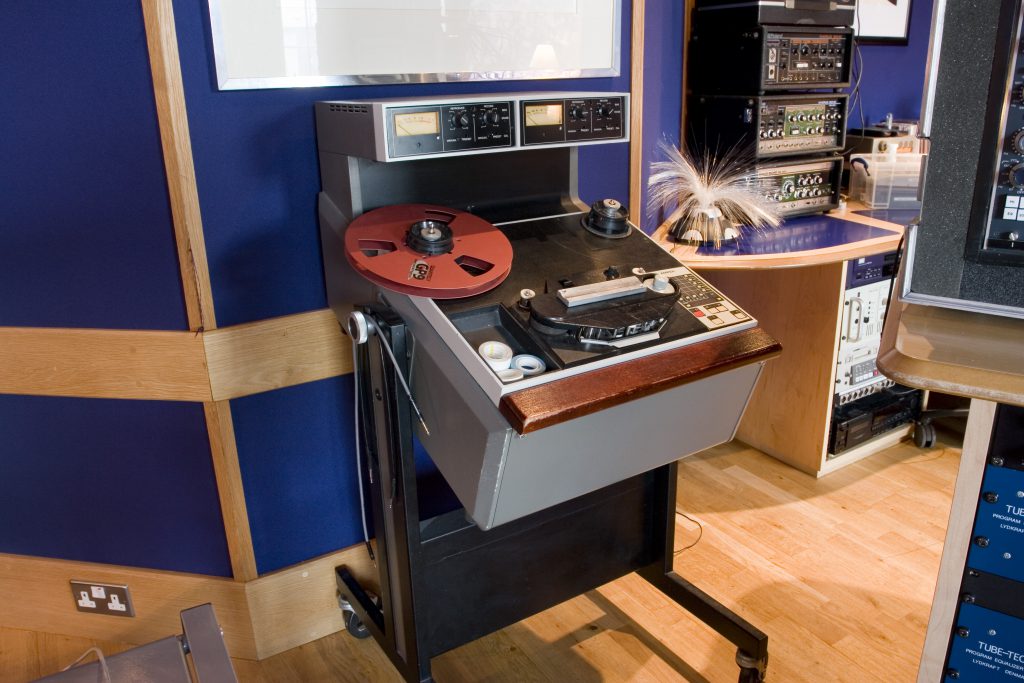
Hugh’s reconditioned Ampex ATR100 analogue half-inch two-track
Analogue and Digital
Although Hugh’s preference is for analogue recording, his Pro Tools system does have an important role to play in his working methods, and nowadays he definitely prefers to edit audio in the DAW. “If I am recording a band I always work in analogue through the console, recording the backing guitar, bass and drums tracks onto 24-track, then recording that into Pro Tools and overdubbing digitally. If I have plenty of time, I sometimes record the overdubs onto tape as well and synchronize the machine with Pro Tools.
“In the old days, the budget for 2-inch tape would be more than the budget for most modern albums, because tape is very expensive, but the great thing about transferring the mix into Pro Tools is that you don’t wear the tape out by rubbing it over the heads the whole time, so you can use it again and again. I have 20 reels of tape that I gradually work through and, relatively speaking, it has a long shelf life.”
Conversely, Hugh has found that analogue processing and recording is beneficial to the digital mixing process, because it means he doesn’t have to rely on using lots of processor-hungry plug-ins later on. This enables him to record at very high resolutions. “I can do that because I don’t use up DSP on plug-ins, whereas some people use masses of plug-ins and are forced to record at 44.1 or 48KHz. I always recode a minimum of double that now. I think a lot of modern music sounds dreadful because it is completely created in the box, and probably at low resolution. I find that when you listen to an individual track recorded at 44.1KHz it can sound fine compared to what’s coming out of the console, but it is when you mix everything together that it doesn’t sound right.
“I’ll push the tape level more or less depending on what the music requires, but I don’t have Dolby because that’s another thing to go wrong and most of the time tape noise isn’t a problem for rock bands.”
Padgham’s Choice
Despite having a fine collection of gear enabling him to recreate pretty much any sound he wants, there are a few products Hugh rates above all others for their all-round usefulness in the studio. This includes his flightcase of vintage Neve 1064 and 1081 preamp/EQs, two UREI 1176s, plus Shure SM57 and Neumann U87 microphones. “That equipment list covers everything as far as I’m concerned, one way or another,” he reveals. “If I could only have a few bits of gear, those would be them. The Neve EQ has a class-A preamp in it that sounds so nice and the EQ in it is very smooth and musical. They are a classic design, and nine, or even ten, things out of ten sound good recorded with them. All the Police albums I did were through those when they had the console in Montserrat. I have a rack of 10, now and it’s very rare that I record something that doesn’t go through them.
“I do have some remakes, like the UA 2-610 mic preamps from the consoles of the early 1960s, which are a very faithful redesign and sound great too; and the Teletronix LA-2A and Retro Instruments Sta-level compressor. The Manley Variable-MU is not a copy but I use that quite a lot. My Empirical Labs Distressors are also very good, although a much more modern. They can supposedly emulate the sound of other compressors like the 1176. I’m not sure whether they substitute the real thing but they are very good in their own right and I use them for lots of things.”
“I could go on forever buying gear but I’ve filled the racks and have most of what I like! But what’s very important is to keep it all working because there is nothing worse than going to studios where half the stuff is broken down. Being a private studio I don’t have a full-time maintenance engineer but I use two ex-Townhouse and CBS engineers, who are on call at any time and know all this analogue gear – I don’t think too many people really know how to set a tape machine up. A 24-track machine has lots of mechanical parts to be serviced and tensions to be set with springs. They are an unbelievable piece of engineering when you look at them. In some ways, for me, the gear in the studio is a bit like having a model train set! It’s a hobby as much as anything.”
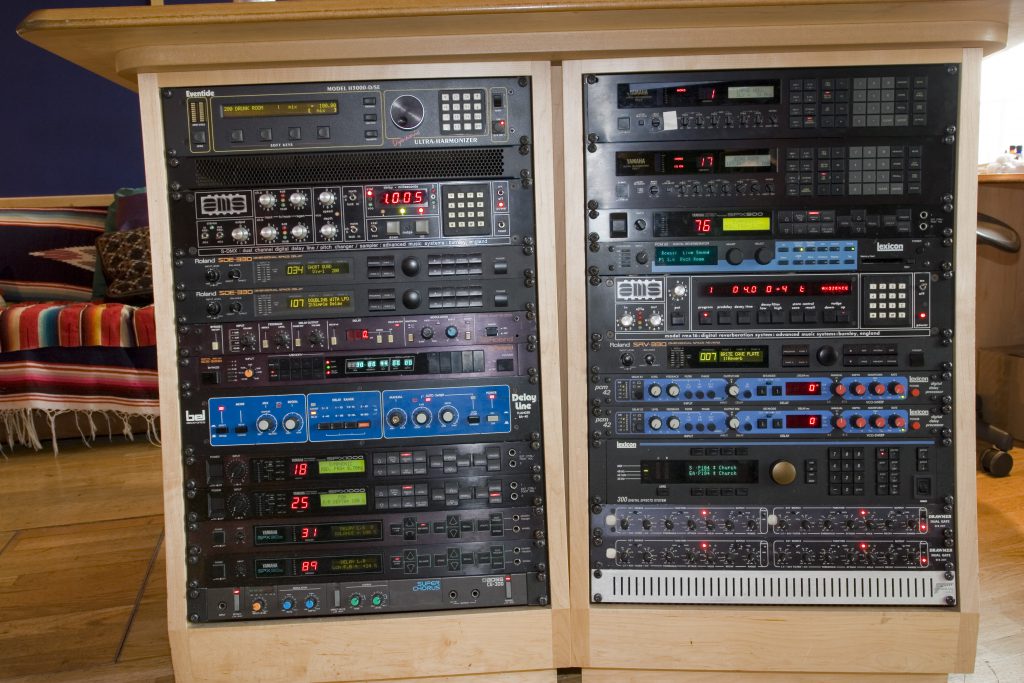
Racks!
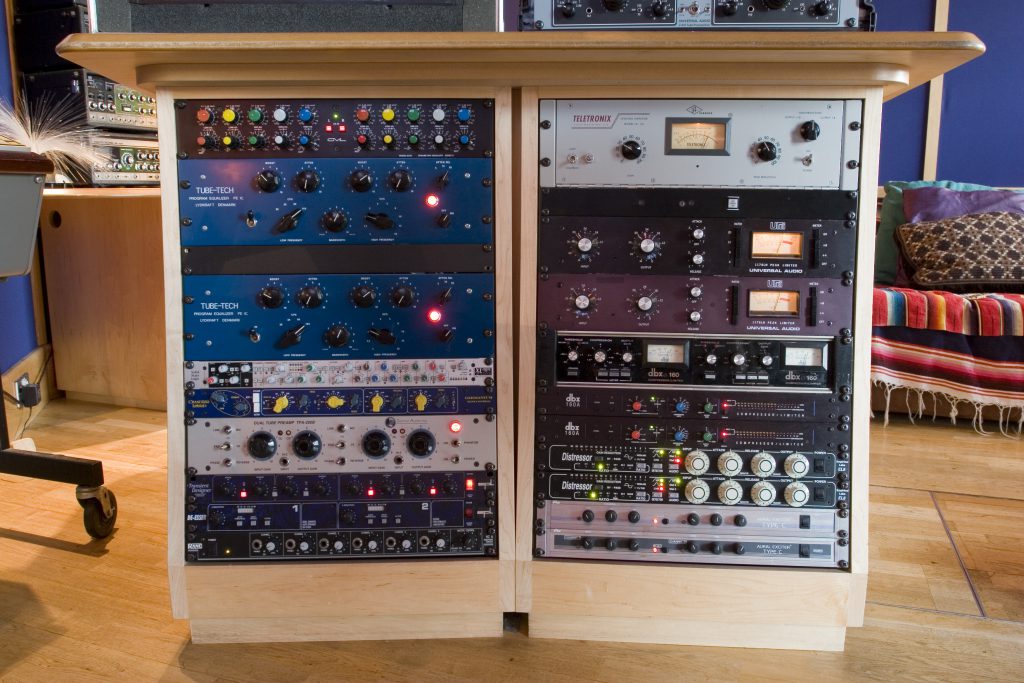
More racks…
Braving the Climate
At a time when many of London’s top studios are closing, Hugh’s purchase of Stanley House seems a brave move. Nevertheless, he insists that it is a good idea, and the only realistic way a studio can survive today. “It’s good to own your own bricks and mortar. If you look around the, the only London recording studios that are surviving, whether they’re private or commercial, like RAK, Abbey Road and Angel, own their own bricks and mortar. Of course, if you ever feel like packing it in you can sell the building.
“The problem studios face is that the people who run them have to pay extortionate rents and ever since it became possible to record something in your bedroom, record companies haven’t wanted to pay for artists to come into proper studios. That is completely and utterly biting the hand that feeds them. I think they are pretty much the prime destroyer of studios so I don’t really work for labels any more; I have such antagonism towards them.
“The art of recording is gradually being lost and no one talks about whether a record sounds good anymore. I don’t see how you can record a rock band in your bedroom. I’m working with several artists at the moment and none of them want to sign to a record label because they know the deal is going to be rotten.”
“There is a London band that I am developing called Lo-Star. Hopefully you’ll hear about them soon. They don’t want to be signed, but I have done a business deal with them and sponsored the making of their album. Producers used to make money from record royalties, but the sales of records are so depressed that you can’t any longer. It’s like a loss leader, and if the producer doesn’t have some ownership in the music copyright then they are not going to make a living. I am not going to spend six months making a record in the hope of getting a royalty later down the line, so I have a deal with the band and if it takes off then I’ll benefit and the studio will get paid. I think that is the way a lot of people are working these days. The old days of assuming a great band will automatically sell are long gone.
“Secondly I did an album with a friend of mine called Dominic Miller, who’s Sting’s guitar player, and thirdly I’ve just done an album for Extreme Music which you could describe as a library music company who place your music into movies or commercials. It’s a way of exploiting music now that the old model no longer works. I’m just about to start doing my second album for them. It’s been great fun because I have more musical freedom.
“It is really quite healthy at the moment because there are a million ways of doing your music and things change all the time. This time last year no one had heard of Twitter, for example, but now it is a household word. I would imagine record labels will ultimately just become music distributors and promoters. We’ll have to see!” TF
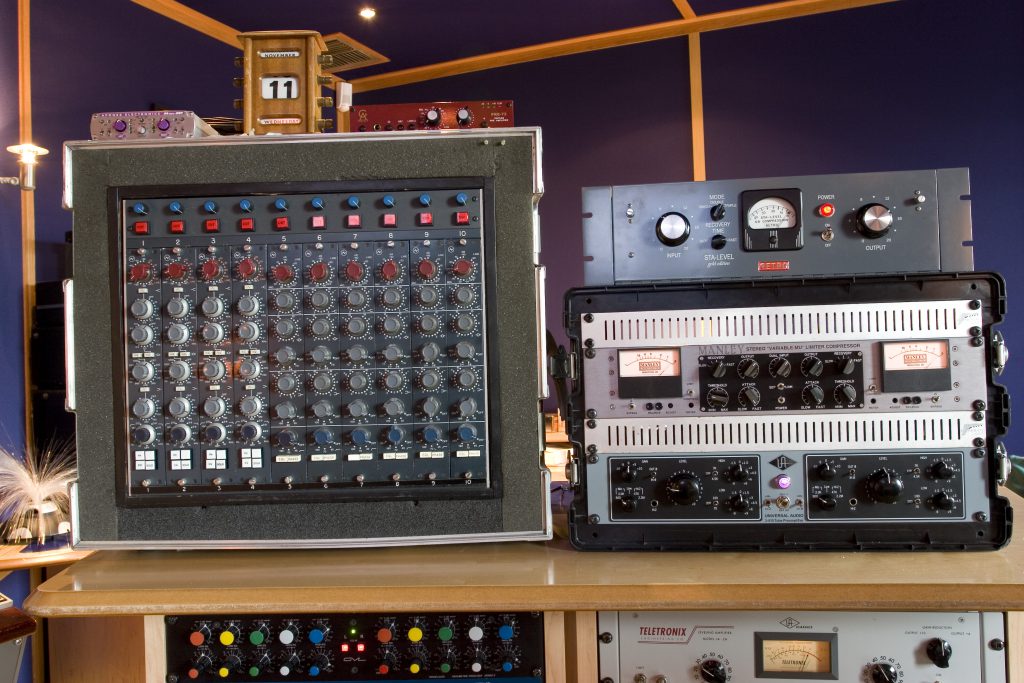
Hugh’s vintage Neve 1064 and 1081 preamp/EQs
Studio Gear list:
CONSOLE
SSL G+ Series fully automated 64 channel console (+ 4 stereo)
MULTITRACK/HARD DISK RECORDING
Protools HD3 Accel with 32 inputs and 48 outputs
Studer A800 MkIII 24-track 2-inch
MONITORING
Quested HQ410 3-way monitors
KRK V6
KRK Expose 8
Yamaha NS10M
AR 18LS /Auratones
Sony Mini speakers
Amplifiers: Quested/Bryston
MASTERING
Ampex ATR102 1/2-inch
Panasonic SV3800 DAT Player
Tascam DA60 MkII Timecode DAT
HHB CD Recorder
DYNAMICS
SSL XL Logic Channel Strip
Teletronix LA-2A
Urei 1176LN (x2)
DBX 160 (x2)
DBX 160A (x2)
Empirical Labs Distressors (x2)
AH Mini Limiter (x2)
SPL De-esser
SPL Transient Designer (4-channel version)
Drawmer DS201 Noise Gates (x2)
EQUALISATION/MIC PRE’S
Massenberg (GML) 8200
Tubetech PE-1C (x2)
Neve 1064 (x6)
Neve 1081 (x4)
Summit TPA200B Stereo Valve Preamp
Apogee Mini MP Stereo Mic Preamp
Universal Audio 2-610 Valve Preamp
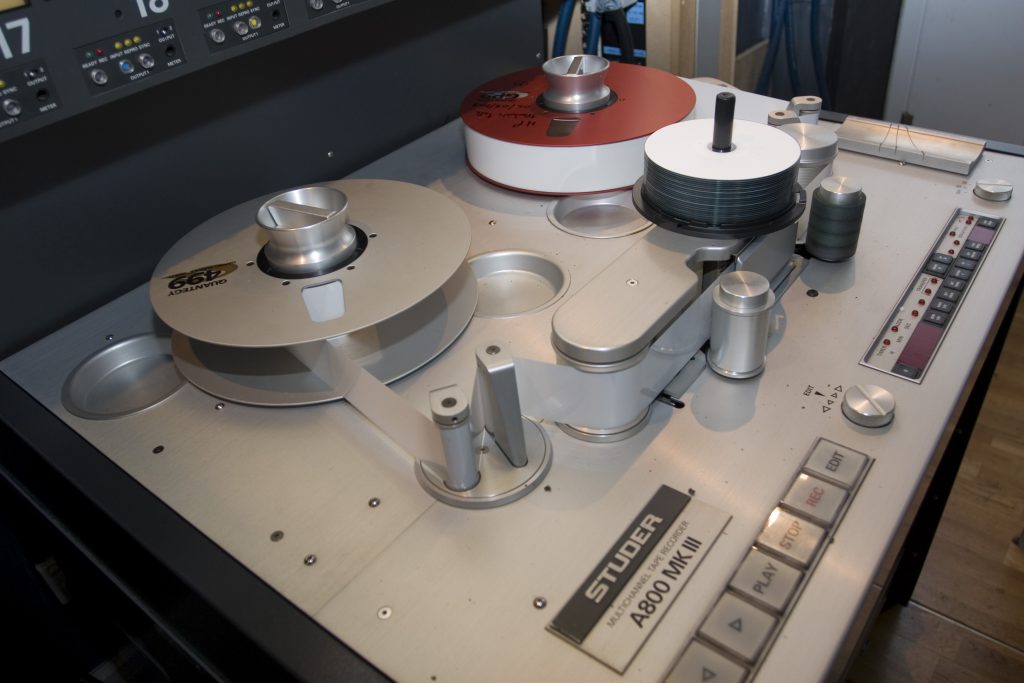
Studer A800 MKIII
REVERBERATION
Lexicon 480L
Lexicon PCM90
EMT 140 Plate Reverb
AMS RMX16
Roland SRV330
DELAYS/PROCESSORS
AMS DMX 1580S
Roland SDE330 (x2)
Lexicon PCM42
Roland SDE3000
Roland SDE2000
Eventide H3000
Yamaha SPX1000 (x2)
Yamaha SPX90 (x3)
Yamaha SPX900
Yamaha Rev 7 (x2)
Boss CE300 Super Chorus
Roland Space Echo RE201
Roland Chorus Echo RE301
Roland Space Echo RE501
Line6 MM4 Modulation Modeller
Aural Exciter Type C (x2)
Aphex Expressor
SYNCHRONISATION
Apogee Big Ben Master Clock
SEQUENCING
Protools v7.3
INSTRUMENTS
Yamaha Upright Piano
MICROPHONES
AKG 414EB
AKG C451E
AKG D112
AKG D12E
Audio-Technica ATM25 (x2)
Audio-Technica ATM23HE (x2)
Audio-Technica ATM35
Audio-Technica ATM87R
Audio Technica AT4041
Audio Technica AT4050
Coles 4038 Ribbon Mics (x2)
Earthworks TC/40K (x2)
Electrovoice RE20
Neumann KM84i
Neumann KM86i (x2)
Neumann U47 Fet (x2)
Neumann U87i (x4)
Oktava MK219 (x2)
Reslo RBT/H (x2)
Rode NT5 Matched Pair (x2)
SE Electronics SE3 Matched Pair (x2)
SE Electronics Z5600A Valve Mic
SE Electronics Gemini Valve Mic
Sennheiser MD421 (x4)
Shure SM57 (x4)
Shure SM58 (x2)
Shure Unidyne 57
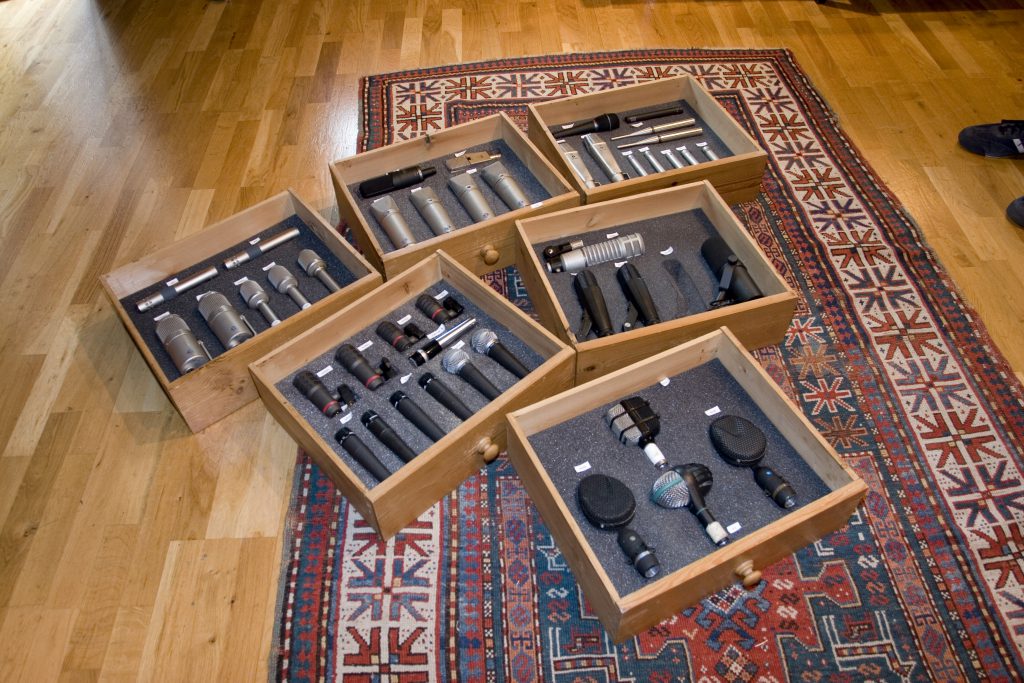
Some of Hugh’s mics
HARDWARE
Apple Quad 2.5GHz G5
Apple 20-inch Cinema Display
3 x Apogee 192 DA16x interfaces providing 48 Outputs
3 x Apogee 192 AD16x interfaces providing 32 Inputs
Apogee Big Ben Master Clock
Digidesign Sync I/O synchronizer
SOFTWARE
OSX 10.4.8
Protools v7.3.1cs4
Logic Pro v7.2.2
Roxio Toast 8
PLUG-INS
Access Music Indigo v7.3
Amp farm v3.0
Amplitude v1.2
Autotune v4.3.0
Avox Choir v1.0.7
Avox Punch v1.0.6
Band Delays v1.2.2
BF Essentials v7.3
BFD v1.0.10.21
Bomb Factory 1176 v7.3
Bomb Factory BF-3A v7.3
Cosmonaut Voice v7.3
D-fi v7.3
Digirack Plugins v7.3
Drumagog v1.0x0
EMI TG12413
Focusrite D2 v7.3
Focusrite D3 v7.3
Funk Logic Masterizer v7.3
Joe Meek SC2 Compressor v7.3
Joe Meek VC5 Meequalizer v7.3
Massenburg Design EQ v1.4.0
Maxim v7.3
moogerfooger Lowpass filter v7.3
Pitch v7.3
Princetown 2016 Plate Reverb
Pultec EQH-2 v7.3
Pultec EQP-1A v7.3
Pultec MEQ-15 v7.3
Sansamp PSA-1 v7.3
Smack! v7.3
Spectron SST-282 v2.03
Tel-Ray Variable Delay v7.3
T-Racks EQ v1.2.1
TL Everyphase v1.1.1.5
TL Space v1.1.3.5
Ultra-Channel v1.0.1
URS 1975 Compressor v1.0b6
URS Strip v1.1b1
Voce Spin v7.3
Voce Chorus/Vibrato v7.3
Waves Platinum v5.4.5
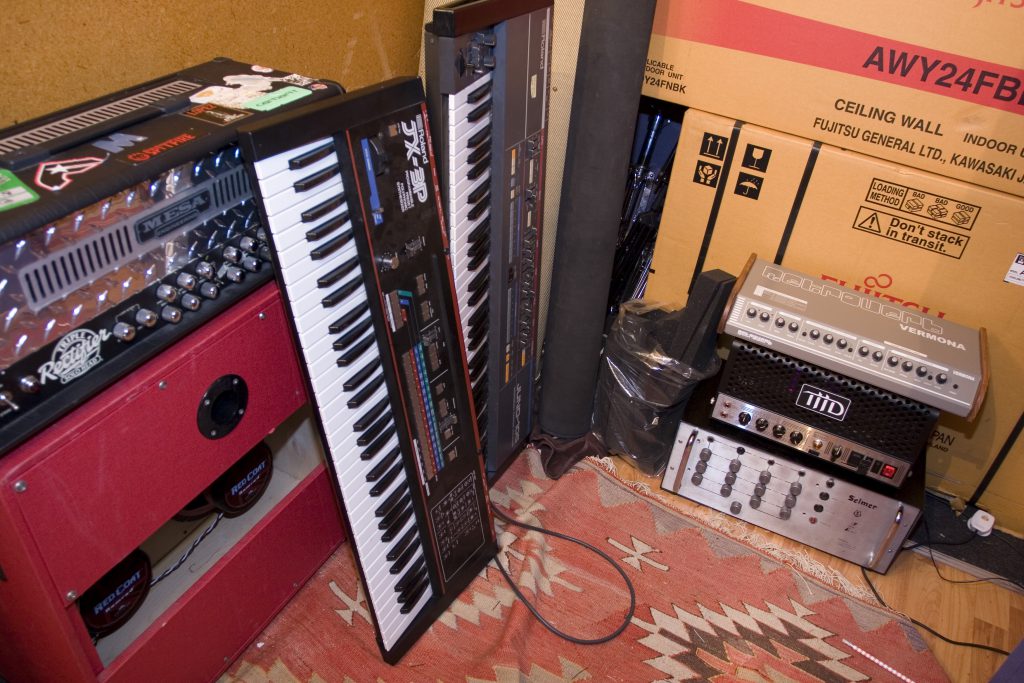
Bits and bobs
See also our interview with Alan Moulder here: Assault & Battery 2 Studios
And our interview with Marius de Vries here: Marius de Vries: Brave New World


